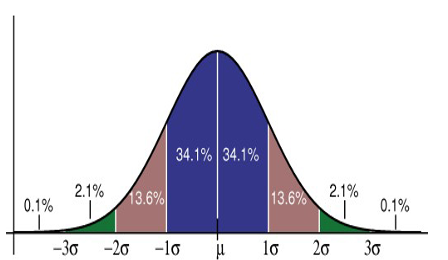Enterprise Implementations and the Normal Distribution

We all remember normal distribution and standard deviation from our statistics classes. I’ve always felt that enterprise software implementations typically follow the normal distribution model. Two percent are fantastic successes, exceeding expectations. Another two percent are miserable failures, maybe even abandoned projects. The rest are two standard deviations to the left or to the right of the mean.

Enterprise software, especially for core back-office functions (Finance, Procurement, HR, Payroll) has been in the mainstream market since the 1980’s. And the functionality is very mature. New software vendors have entered the market, especially for Cloud applications. While there is always a shakedown period, many of the current Cloud applications like Oracle’s, were first introduced over 10 years ago.
Organizations can successfully choose the right software for their industry that meets most of their needs. Project management tools and techniques have evolved to the point where they are effectively utilized on most projects. Impacted stakeholders are aware of the basics, e.g., realistic schedules, executive support, tracking requirements, testing, and training.
So why is the failure rate so high? Given that the software is mostly mature, and organizations understand the basics of managing software applications, where is the failure point? After 40 years of working with enterprise applications, I think the quote below sums it up.
“The Single Biggest Failure Point for ERP Implementations is Change Management”.
This quote by Neville Turbet was taken from a report by Deloitte Canada entitled, “Your Guide to a Successful ERP Journey”. Neville Turbet is the owner of a project management firm in Australia called Project Perfect.
Although change management has been a project management function forever, I contend that the execution of effective change management is the failure point. In many cases, it is the first thing that gets cut, either when the bid or contract is in play or when the project is having financial challenges.
Effective change management is even more important when implementing Cloud applications. While Cloud applications are highly configurable, they typically cannot be modified like previous on-premise software applications. People must adapt to and adopt business processes to conform to the chosen software applications.
At Meta, we prioritize people over process and technology in what we refer to as People Driven ROI. We empower your people to drive business processes using technology as the enabler. With our People Driven ROI approach, change management is embedded in every aspect of our projects. Our people, methodology, and tools actively engage your project team and employees throughout the entire project to bridge the gap between your current state and the future state.
As the saying goes, “you can pay now or pay later”. Including effective change management throughout the project lifecycle minimizes risk, drives long-term adoption, and will keep you on the positive side of the normal distribution.
Bob Sabo has over 40 years of experience working for government or for private sector companies providing technology services to the public sector.
Matt Leibold has 20 years of experience helping private and public sector organizations understand, utilize, and adopt enterprise software applications.







